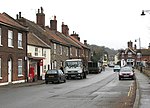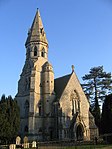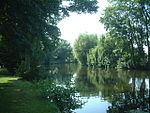Bixley medieval settlement
Deserted medieval villages in NorfolkScheduled monuments in Norfolk

Bixley medieval settlement is a deserted medieval village in Norfolk, England, about 2 miles (3.2 km) south-east of Norwich. It is a Scheduled Monument.
Excerpt from the Wikipedia article Bixley medieval settlement (License: CC BY-SA 3.0, Authors, Images).Bixley medieval settlement
Church Loke, South Norfolk Caistor St Edmund and Bixley
Geographical coordinates (GPS) Address Website Nearby Places Show on map
Geographical coordinates (GPS)
| Latitude | Longitude |
|---|---|
| N 52.595 ° | E 1.3352777777778 ° |
Address
Saint Wandregesilius (Saint Wandregesilius' Church)
Church Loke
NR14 8RY South Norfolk, Caistor St Edmund and Bixley
England, United Kingdom
Open on Google Maps









